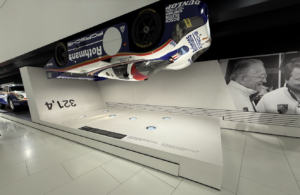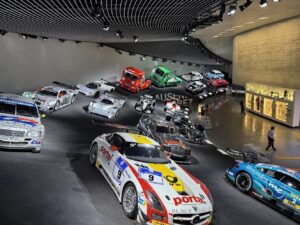The Birthplace of Mercedes
Last weekend, I made the trip to Stuttgart to see the birthplace of two of the coolest (in my opinion at least) car companies in the world. Although their stories are completely different in both nature and timing, I found it extremely interesting to see and learn about the history of both Porsche and Mercedes via their respective museums. Initially, I had planned on going mostly to see the Porsche Museum, expecting it to be geared significantly more toward the incredible list of engineering and racing stories held by the Porsche name while the Mercedes Museum would focus more on surface-level information about relatively unexciting information. After visiting both, I can confidently say that I was completely wrong about how interesting these museums would be relative to each other and can confidently say that by comparison the Mercedes Museum was substantially more interesting.
While the Porsche Museum focuses heavily on their history of racing and performance, the car-by-car structure of attaching only a short

block of text to each display (mostly cars) made it difficult to draw out a story, leaving out seemingly important context that would explain the connection between cars and bring their projects together to build a name for the brand.
The Mercedes-Benz Museum, however, was one of the coolest museums I’ve ever been to, taking advantage of the incredibly long and rich history of the brand to build a true picture of the history of Mercedes through both their projects and the impact that they’ve had on the world since their inception. The museum begins as far back as the initial Daimler Engine, explaining the desire and struggle to create an engine that was able to deviate far enough from the Otto cycle to avoid patent-infringement – while achieving a similar result of outputting work – and takes the story all the way to modern-day Mercedes-Benz, explaining the company’s early business selling cars to French resellers and their

involvement in the war efforts of the Third Reich under the control of Nazi Germany. The museum’s vast collection of both pieces (cars, planes, engines) and historical context — it was almost difficult to walk around the museum without seeing some sort of text explaining contemporary events – made it easy to get lost in not only the history of Mercedes but the history of the time period of the section I was standing in.
While the vast reach of the Mercedes brand made it
easy to pack a lot of history into such a large building, I think that the museum’s ability to balance between time periods and vehicle themes (safety, cargo, efficiency, motorsport, etc.) made it extremely easy to get lost in what could very easily be a boring museum with little to learn. Mercedes’ willingness to open up about information surrounding both the positive and negative sides of their history while also putting enough technical detail in to ensure that everyone learns something new made this museum my favorite stop on my trip to Stuttgart, an experience I’d recommend to anyone passing through the city.
-Sean M.
- Smithsonian National Air and Space Museum. (n.d.). Daimler-Motoren (Mercedes) DIII AVU, in-line 6 engine. Daimler-Motoren (Mercedes) DIII Avu, In-line 6 Engine | National Air and Space Museum. https://airandspace.si.edu/collection-objects/daimler-motoren-mercedes-diii-avu-line-6-engine/nasm_A19840907000
